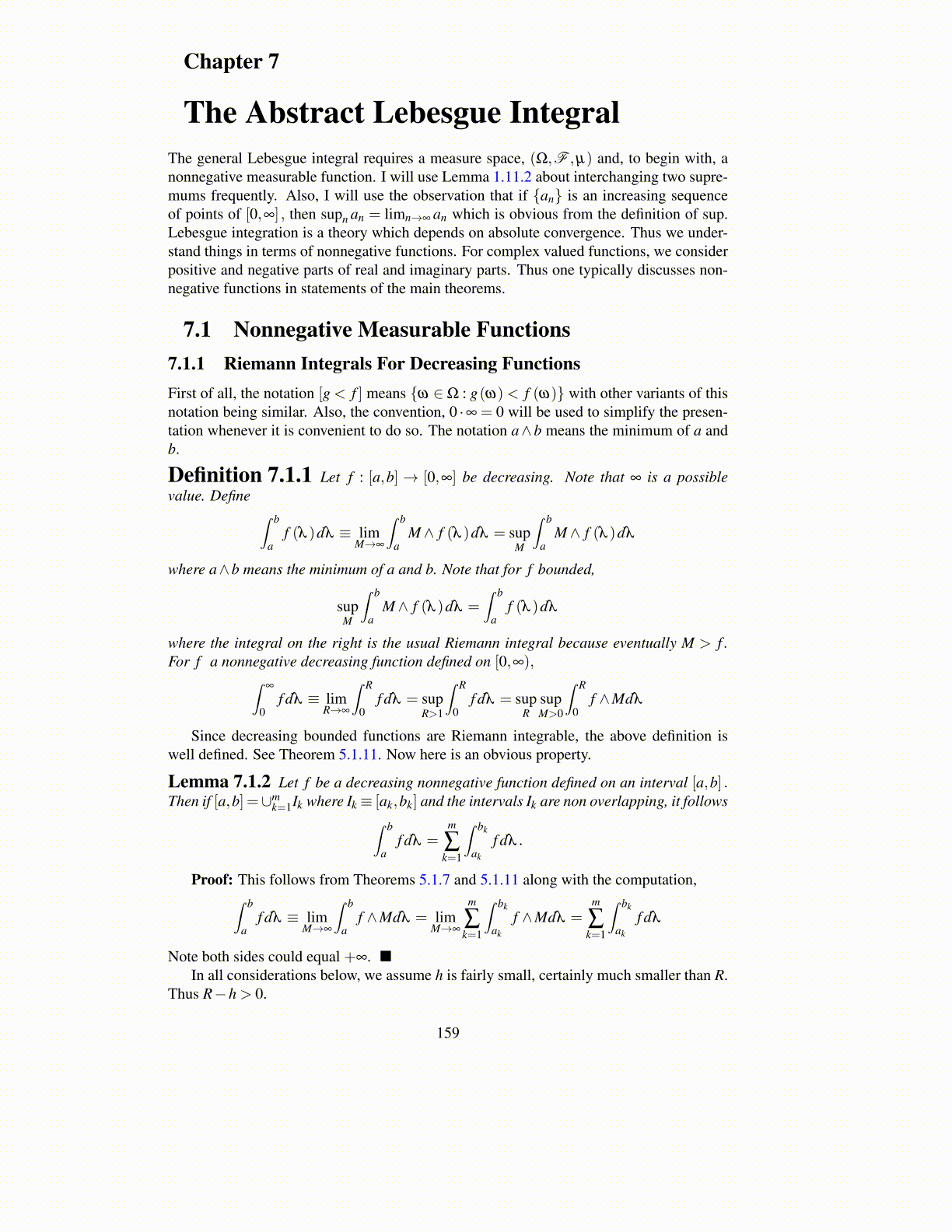
Chapter 7
The Abstract Lebesgue IntegralThe general Lebesgue integral requires a measure space, (Ω,F ,µ) and, to begin with, anonnegative measurable function. I will use Lemma 1.11.2 about interchanging two supre-mums frequently. Also, I will use the observation that if {an} is an increasing sequenceof points of [0,∞] , then supn an = limn→∞ an which is obvious from the definition of sup.Lebesgue integration is a theory which depends on absolute convergence. Thus we under-stand things in terms of nonnegative functions. For complex valued functions, we considerpositive and negative parts of real and imaginary parts. Thus one typically discusses non-negative functions in statements of the main theorems.
7.1 Nonnegative Measurable Functions7.1.1 Riemann Integrals For Decreasing FunctionsFirst of all, the notation [g < f ] means {ω ∈Ω : g(ω)< f (ω)} with other variants of thisnotation being similar. Also, the convention, 0 ·∞ = 0 will be used to simplify the presen-tation whenever it is convenient to do so. The notation a∧b means the minimum of a andb.
Definition 7.1.1 Let f : [a,b]→ [0,∞] be decreasing. Note that ∞ is a possiblevalue. Define ∫ b
af (λ )dλ ≡ lim
M→∞
∫ b
aM∧ f (λ )dλ = sup
M
∫ b
aM∧ f (λ )dλ
where a∧b means the minimum of a and b. Note that for f bounded,
supM
∫ b
aM∧ f (λ )dλ =
∫ b
af (λ )dλ
where the integral on the right is the usual Riemann integral because eventually M > f .For f a nonnegative decreasing function defined on [0,∞),∫
∞
0f dλ ≡ lim
R→∞
∫ R
0f dλ = sup
R>1
∫ R
0f dλ = sup
RsupM>0
∫ R
0f ∧Mdλ
Since decreasing bounded functions are Riemann integrable, the above definition iswell defined. See Theorem 5.1.11. Now here is an obvious property.
Lemma 7.1.2 Let f be a decreasing nonnegative function defined on an interval [a,b] .Then if [a,b] =∪m
k=1Ik where Ik ≡ [ak,bk] and the intervals Ik are non overlapping, it follows∫ b
af dλ =
m
∑k=1
∫ bk
ak
f dλ .
Proof: This follows from Theorems 5.1.7 and 5.1.11 along with the computation,∫ b
af dλ ≡ lim
M→∞
∫ b
af ∧Mdλ = lim
M→∞
m
∑k=1
∫ bk
ak
f ∧Mdλ =m
∑k=1
∫ bk
ak
f dλ
Note both sides could equal +∞. ■In all considerations below, we assume h is fairly small, certainly much smaller than R.
Thus R−h > 0.
159